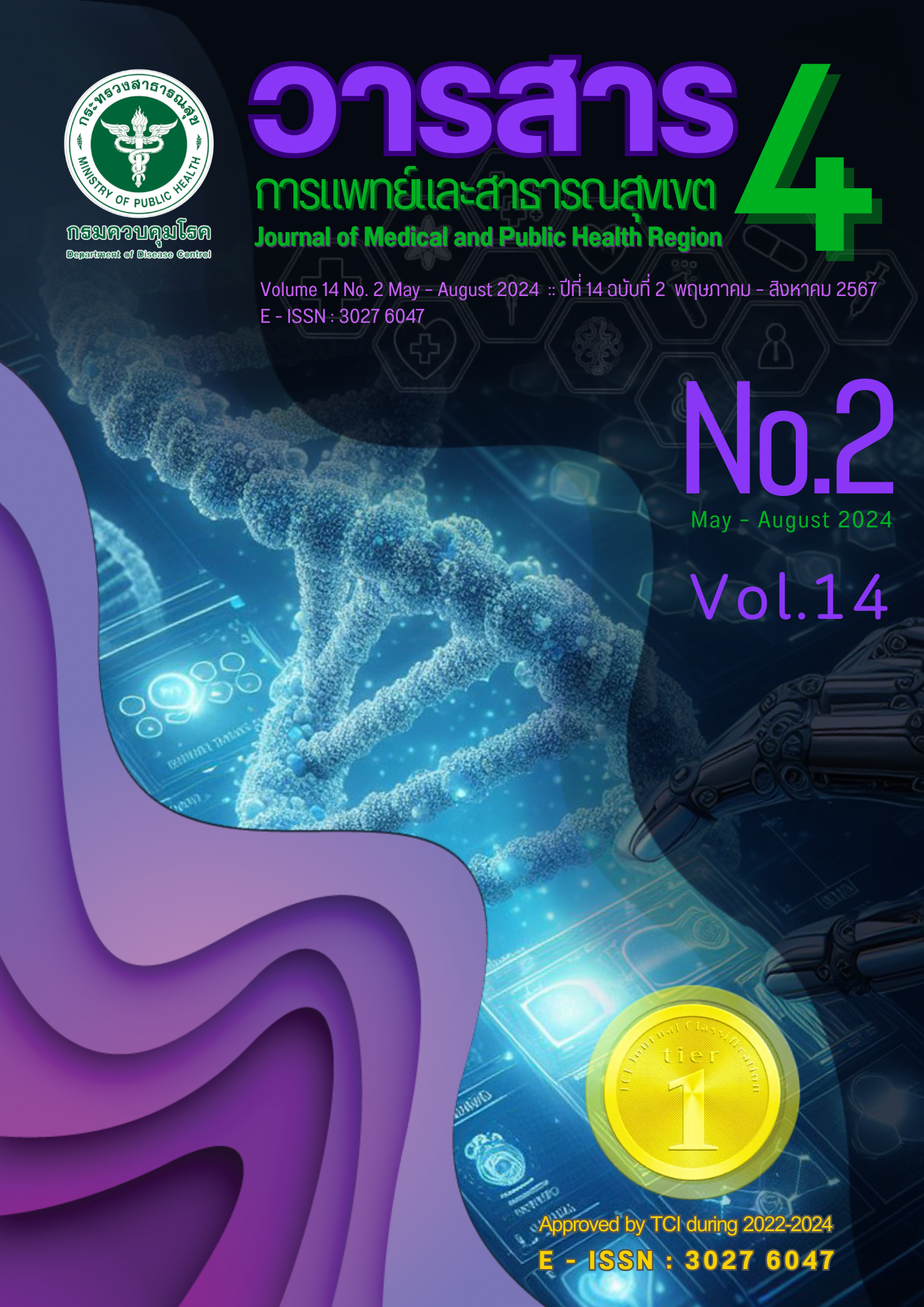Infection of encysted trematode metacercariae in Cyprinoid fish from the middle Mun-upper Chi River basin of Thailand, with micromorphological and molecular approach using
Main Article Content
Abstract
The Cyprinoid fish play a crucial role in the distribution and proliferation of trematode metacercariae in the ecosystem. They also serve as significant intermediate hosts transmitting liver fluke diseases to humans. However, there is a lack of epidemiological surveillance data on the second intermediate host in the river basins of the at-risk areas of Nakhon Ratchasima, Buriram, Surin and Chaiyaphum provinces. Therefore, information on infection in disease reservoir hosts is essential. This study focuses on the infection of trematode metacercariae and aims to develop sentinel surveillance methods using micromorphological and molecular techniques. The study area encompasses 11 sub-districts in the middle Mun-upper Chi River basin of Thailand. A total of 813 fresh fish samples, representing four species of Cyprinoid fish, were collected. The samples underwent pepsin HCL digestion and were subsequently confirmed via PCR, revealing the presence of Haplorchoides sp. metacercariae in 5 sub-districts in Buriram province during the winter season, Opisthorchis viverrini (Ov) metacercariae in 2 sub-districts in Chaiyaphum province during the rainy season, and unknown metacercariae in 4 sub-districts in Nakhon Ratchasima, Chaiyaphum, and Surin provinces during the rainy season. Ov metacercariae were also found in 1 sub-district in Nakhon Ratchasima province during the rainy season. Micromorphological examination of Haplorchoides sp. metacercariae was performed, and illustrations were created as supporting references. This study emphasizes that Cyprinoid fish act as second intermediate hosts for many species of trematodes, and in the upper Chi River basin, there continues to be contamination with Ov metacercariae. The collaboration of local networks is crucial for monitoring the epidemic spread of intermediate hosts transmitting diseases to humans in the areas of regional health 9.
Article Details

This work is licensed under a Creative Commons Attribution-NonCommercial-NoDerivatives 4.0 International License.
References
Morakote N, Sukontason K. editors. Medical parasitology: II. helminths. 3rd ed. Chiang Mai: Chiang Mai University; 2011. (in Thai)
Ampan P. Prevalence of opisthorchis viverrini infection in intermediate hosts in Hua Na dam area, Sisaket province: 2014. Disease Control Journal 2015; 4(3): 227-40. (in Thai)
Suntaravitun P, Dokmaikaw A. Prevalence of trematode metacercariae in Cyprinoid fish from Rim Kok subdistrict, Mueang Chiang Rai district, Chiang Rai province. Journal of Mahanakorn Veterinary Medicine 2014; 9(2): 113-20. (in Thai)
IARC. Biological agents. Vo. 100 B. a review of human carcinogens. IARC Monogr Eval Carcinog Risks Hum. 2012; 100: 1–441.
Boonpan T, Kantongdang T. The detection of Opisthorchis viverrini metacercaria in Cyprinoid fish by polymerase chain reaction (PCR) [Research project B.Sc.Medical Technology]. Khon Kaen: Khon Kaen University; 2015. (in Thai)
Kamchoo K, Chai JY. Trematode metacercariae and adults in cyprinoid fish from Khun Thale Swamp in Surat Thani province, Thailand. Parasites Hosts Dis. 2023; 61(2): 163-71. doi:10.3347/PHD.23030
Suntaravitun P. Trematode metacercariae in freshwater fishes of Thailand. Burapha Science Journal 2014; 19(2): 237-49. (in Thai)
Purivirojkul W. A survey of fish species infected with trematode metacercariae from some areas in northeast Thailand. Journal of Fisheries Technology Research 2011; 5(2): 75-86. (in Thai)
Nelson J, Grande T, Wilson M. Fishes of the world, fifth edition. John Wiley & Sons, New York, USA,601 pp. Available from: https://doi.org/10.1002/9781119174844
Shameem U, Madhavi R. The morphology, life-history and systematic position of Haplorchoides mehrai Pande & Shukla, 1976 (Trematoda: Heterophyidae). Systematic Parasitology 2004; 11:73-83. Available from: https://doi.org/10.1007/BF00006979
Scholz T, Ditrich O, Giboda M. Differential diagnosis of opisthorchid and heterophyid metacercariae (Trematoda) infection of flesh cyprinoid fish from Nam Ngum Dam Lake in Laos. Southeast Asian J Trop Med Public Health 1991; 22:171-3.
Phyo Myint EE, Sereemaspun A, Rocklöv J, Nithikathkul C. Discovery of carcinogenic liver fluke metacercariae in second intermediate hosts and surveillance on fish-borne trematode metacercariae infections in Mekong Region of Myanmar. Int J Environ Res Public Health. 2020; 17(11): 4108. doi: 10.3390/ijerph17114108. PMID: 32526911; PMCID: PMC7312695.


